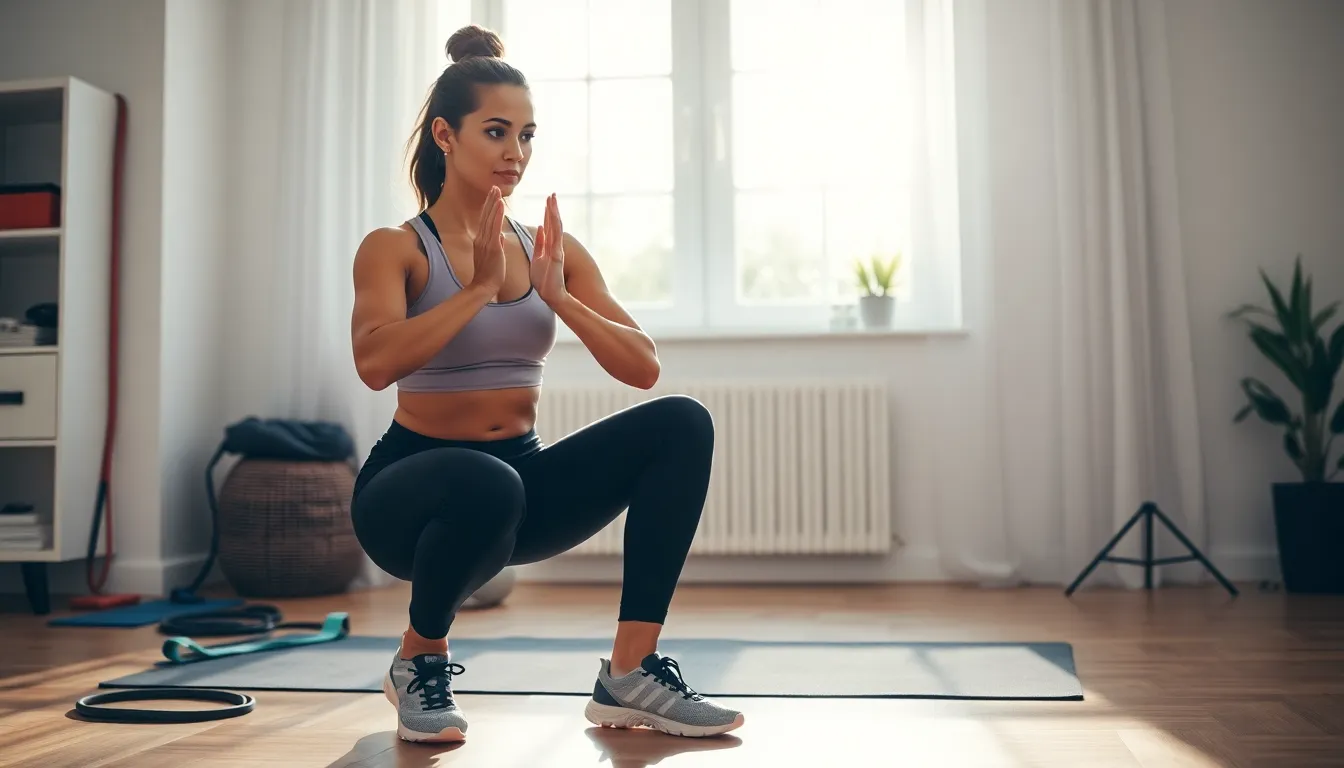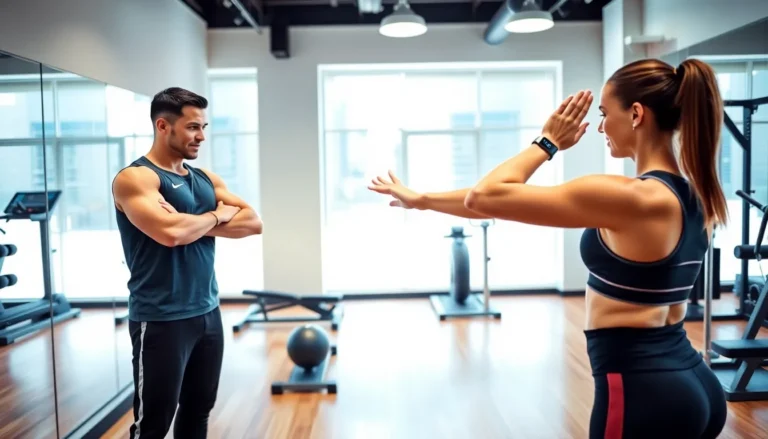Table of Contents
ToggleStarting a fitness journey can feel overwhelming, especially for beginners. With countless workout plans and fitness trends flooding the market, it’s tough to know where to begin. The key is to find a structured plan that fits individual needs and goals, making the process enjoyable and sustainable.
Beginner workout plans serve as a roadmap, guiding newcomers through essential exercises that build strength, endurance, and confidence. These plans focus on foundational movements, ensuring proper form and technique while gradually increasing intensity. Whether aiming to lose weight, gain muscle, or simply improve overall health, the right workout plan can make all the difference in achieving lasting results.
Understanding Beginner Workout Plans
Beginner workout plans provide essential guidance for newcomers in fitness. They offer structure that helps individuals navigate their fitness journey effectively.
Importance of a Structured Plan
Structured workout plans play a crucial role in successful fitness initiation. They help individuals set realistic expectations and maintain motivation. Plans outline specific exercises, sets, and repetitions, preventing confusion during workouts. Additionally, structured plans facilitate progression, allowing individuals to gradually increase intensity and complexity. Following a structured approach minimizes the risk of injury by emphasizing proper form and technique.
Common Goals for Beginners
Beginners often pursue several common fitness goals. These goals include:
- Weight Loss: Many individuals focus on shedding excess pounds to improve health and appearance.
- Muscle Gain: Some seek to increase muscle mass for aesthetics or strength enhancement.
- Improved Endurance: Others prioritize building stamina to engage in prolonged physical activities.
- Enhanced Flexibility: Flexibility often becomes a goal for individuals looking to improve overall movement and reduce injury risk.
- General Health Improvement: Some strive for overall better health, seeking to improve cardiovascular fitness and mental well-being.
Identifying specific goals can guide the selection of an appropriate workout plan, ensuring alignment with personal aspirations.
Types of Beginner Workout Plans


Beginner workout plans encompass various approaches tailored to enhance fitness levels. Understanding the different types aids individuals in selecting a plan that aligns with their specific goals.
Strength Training Plans
Strength training plans focus on building muscle and enhancing overall strength. These plans often include:
- Bodyweight exercises: Push-ups, squats, and lunges target multiple muscle groups without equipment.
- Resistance band workouts: Bands provide variable resistance, allowing for controlled movements while reducing injury risk.
- Weightlifting routines: Beginner-friendly weights promote proper form and muscle development, incorporating exercises like bench presses and deadlifts.
These plans typically recommend 2-3 sessions per week, progressing gradually in weight and intensity.
Cardio Plans
Cardio plans emphasize improving cardiovascular health and endurance. Common components include:
- Running or walking: Short distances allow for foundational fitness, increasing time and intensity over weeks.
- Cycling: Stationary bikes or outdoor cycling contribute to building lower body strength and endurance.
- HIIT workouts: High-Intensity Interval Training alternates short bursts of intense activity with rest periods, maximizing calorie burn efficiently.
These plans suggest varying sessions from 20 to 60 minutes, 3-5 times per week.
Flexibility and Mobility Plans
Flexibility and mobility plans prioritize joint health and muscle elasticity. Key elements consist of:
- Static stretching: Holding stretches for 15-30 seconds enhances muscle flexibility and recovery after workouts.
- Dynamic stretching: Engaging in controlled movements prepares muscles for more intense workouts and improves range of motion.
- Yoga routines: Incorporating yoga promotes balance, coordination, and mindfulness, suitable for both beginners and advanced practitioners.
These plans recommend consistent practice, ideally 3-4 times weekly, to ensure improved mobility and reduced risk of injury.
Creating Your Own Beginner Workout Plan
Creating a personalized beginner workout plan involves understanding fitness levels, setting attainable goals, and selecting appropriate exercises. This structured approach ensures a sustainable and effective fitness journey.
Assessing Your Fitness Level
Assessing fitness levels provides a clear starting point. Beginners should consider their current physical capabilities, previous exercise experience, and any existing health conditions. They can evaluate their strength through simple bodyweight exercises, such as push-ups and squats, and assess cardiovascular endurance with activities like brisk walking or jogging. Utilizing fitness assessments can help gauge flexibility through stretches, measuring range of motion. This self-assessment allows individuals to tailor their workout plans to their specific needs, ensuring appropriate progression.
Setting Achievable Goals
Setting achievable goals guides beginners throughout their fitness journey. Effective goals should follow the SMART criteria: Specific, Measurable, Achievable, Relevant, and Time-bound. For instance, rather than stating “get fit,” an individual could set a goal like “complete 20 consecutive push-ups within two months.” Common goals for beginners include losing a specific weight, increasing endurance to run a certain distance, or mastering a specific yoga pose. By aligning goals with personal motivations, individuals maintain their focus and drive in their workout plans.
Choosing the Right Exercises
Choosing the right exercises forms the core of any beginner workout plan. A balanced routine should incorporate strength training, cardio, and flexibility exercises.
- Strength Training: Focus on bodyweight exercises—push-ups, squats, lunges. Start with 1-2 sets of 8-12 repetitions, 2-3 times weekly.
- Cardio: Select enjoyable activities—walking, cycling, or dancing. Aim for sessions lasting 20-30 minutes, at least 3-5 times weekly.
- Flexibility: Incorporate stretching or yoga. Perform stretches that target major muscle groups for 10-15 minutes after workouts or on rest days.
By mixing various exercise types, beginners can create a well-rounded workout plan that maintains engagement and promotes overall fitness development.
Tips for Sticking to Your Beginner Workout Plan
Following a structured workout plan requires commitment and consistency. These tips help beginners maintain their momentum and achieve fitness goals.
Building a Routine
Establishing a workout schedule enhances consistency. Selecting specific days and times during the week for workouts fosters accountability. Incorporating workouts into a daily routine, such as morning sessions before work or evening workouts after dinner, makes exercise a habit. Setting reminders on smartphones or calendars aids in staying on track, while preparing gym clothes in advance eliminates excuses.
Staying Motivated
Finding motivation is crucial for adherence to any workout plan. Setting short-term and long-term goals provides clear targets to strive for. Joining a fitness class or finding a workout buddy creates a sense of community, making workouts more enjoyable. Rewarding personal achievements, such as reaching a milestone or completing a challenging workout, reinforces positive behavior and encourages progress. Visualization techniques, such as picturing the desired outcome or focusing on personal improvements, also cultivate motivation.
Tracking Progress
Monitoring progress helps beginners stay focused and engaged. Keeping a workout journal to log exercises, sets, and personal records reveals patterns and areas for improvement. Utilizing fitness tracking apps or wearable devices quantifies efforts, providing insights into activity level and achievements. Regular fitness assessments, such as measuring weight, body measurements, or performance enhancements, offer tangible evidence of progress. Celebrating milestones, no matter how small, boosts confidence and enthusiasm for continued effort.




